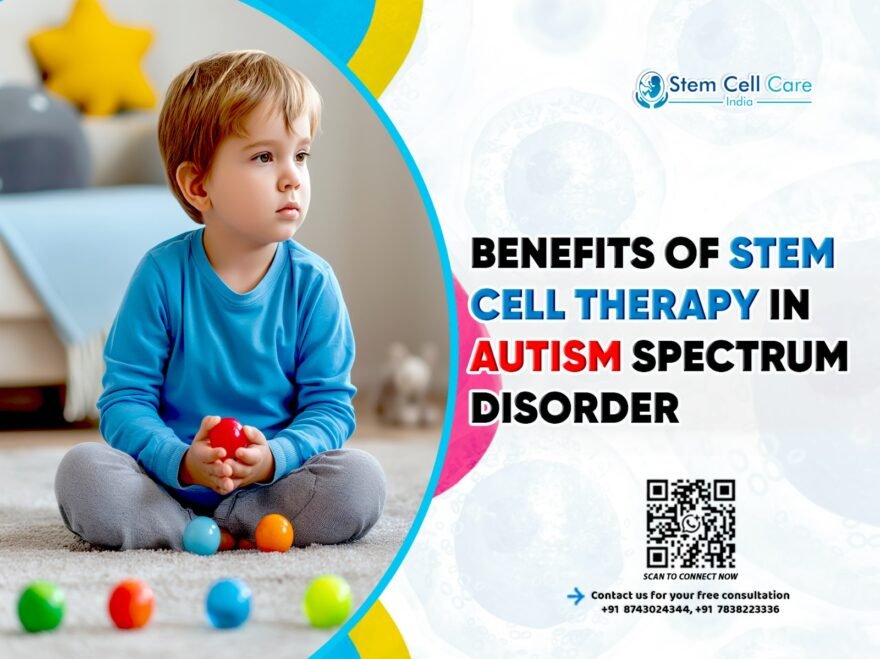Table of Contents
Summary: As you know, autism spectrum disorder (ASD) is a complex neurological condition that makes it difficult to communicate, behave, and do social interaction for a person. While other therapies like speech, occupational, and behavioral therapy only help to manage the symptoms, they do not directly address the root cause. Meanwhile, stem cell therapy is gaining attention as a natural, regenerative option that may support brain repair, improve function, and improve quality of life.
For parents of children with autism, life is a journey through a maze. Every success – from learning new words to eye contact, and interacting with peers in social play – is a monumental effort and a test of patience. While traditional therapies (behavioral therapy, speech therapy, medications) are helpful tools that provide some relief and progress, many still feel strongly that treatments only suppress symptoms on the outside and do not truly address the neurological imbalance on the inside.
This is where stem cell therapy shines. Stem cell therapy is designed to go deeper by promoting repair pathways of the brain and reducing inflammation. Rather than altering behaviors, it strives to restore the subsystems of brain function and ultimately pave the way for new opportunities for children with autism to thrive.
Understanding Stem Cell Therapy
Stem cells are special cells that possess the remarkable ability to convert to a different cell type and regenerate damaged tissue. Mesenchymal stem cells (MSCs) are utilized nearly exclusively in autism treatment because they are regenerative and anti-inflammatory.
Stem cell therapy can assist with autism by:
● Increasing Oxygenation & Blood Flow to the Brain: Improved oxygen and blood flow in the brain improve brain function.
● Decreasing Inflammation: Inflammation of the brain is chronic in most autism children with autism, which can be suppressed by stem cells.
● Fixing Neural Connections: Stem cells can induce novel neural connections in the brain that maximize communication between various parts of the brain.
The focused method tries to mend brain function, which can manifest as good development and improvements in behavior.
How Stem Cell Therapy Can Benefit Autism Patients
Here are some benefits of undertaking stem cell therapy for autism:
1. Improved Communication and Speech
● Communication is the largest area of challenge for children with autism. Parents report the following complaints, such as retarded speech and ineffective speech in expressing emotions.
● Stem cell therapy improves the language centers of the brain so that the child can enhance speech clarity, vocabulary, and improve the ability to express emotions.
2. Decreased Repetitive Behavior
● Autistic children show repetitive behaviors such as hand-flapping, rocking, or word repetition. These conditions are associated with imbalanced brain activity.
● Stem cell therapy can minimize repetitive patterns and improve focus and attention to activities by repairing neural circuits.
3. Improved Social Interaction
● Simple social behavior, such as eye contact, response to name, or play with other children, may be challenging for autistics.
● Stem cell therapy, by enhancing brain connectivity, can potentially make children more attuned to social signals, more connected with others, and better securely attached.
4. Reduce Inflammation and Irritability
● Brain inflammation has been suspected to cause mood swings, hyperactivity, and irritability in autism.
● Stem cells can act as natural anti-inflammatory substances and can dampen aggression, calm hyperactivity, and produce a calmer emotional climate for children and families.
5. Improved Cognitive Development
● Acquisition of new skills and problem-solving can be slower in people with autism.
● By repairing and restoring brain function, stem cell therapy can enable the implementation of better memory, attention span, and flexibility, enabling children to do better in school and everyday life.
Endnotes
Stem cell therapy is casting a beam of hope for Autism Spectrum Disorder parents. By treating underlying neurological issues like inflammation of the brain and impaired neural connections, it can potentially augment communication, behavior, and development. While research is yet to be completed, the majority of parents consider it an excellent addition to conventional therapies.
If you are thinking along this line, contact Stem Cell Care India, a well-reputed stem cell treatment supplier in India. They have specialists who can give counseling, discuss current updates, and assist you in determining whether this new therapy could be for your child.
Frequently Asked Questions
Q1. Will stem cell therapy cure autism?
Ans. No, stem cell therapy won’t cure autism. It might, though, relieve symptoms and improve the quality of life by facilitating brain repair.
Q2. Is it safe for children with autism to undergo stem cell therapy?
Ans. Yes, studies indicate it is generally safe if done under medical care, although safety over the long term is being investigated.
Q3. When can effects be noticed?
Ans. Some families observe changes in weeks, and for others, it could take months. It differs with each child.
Q4. Is stem cell therapy for autism possible in India?
Ans. Yes, India is one of the nations where stem cell therapy for autism is provided. You can consult with Stem Cell Care India to find out more about the options available.


